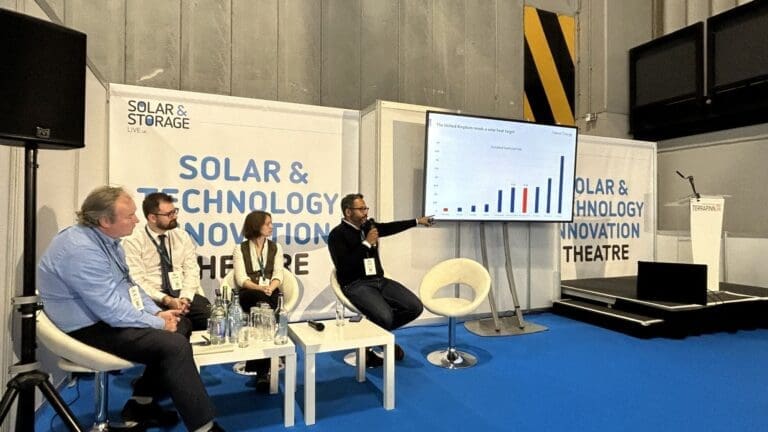
Across Europe and globally, solar thermal is growing in significance for its ability to provide a clean source of heating and hot water, while reducing demand on fossil fuels, reducing reliance on the grid and improving energy security.
Solar Heat Europe is among those actively promoting the use of solar thermal technology for renewable heating and cooling. Its publication ‘Energising Europe with Solar Heat – A Solar Thermal Roadmap’, has been signed by more than 100 entities and sponsors.
Heating is responsible for around 50% of global energy consumption and, according to Solar Heat Europe, solar thermal represents the main ‘low hanging fruit’ among the available solutions for decarbonisation and its emissions saving potential is ‘severely underestimated’.
The UK should have a solar heat target
UK-based Naked Energy is one of the main sponsors of the Solar Heat Europe roadmap, and it was interesting to hear the solar tech firm’s view on the role of solar thermal during a panel discussion at the last Solar and Storage Show.
It asserts that the UK should have a solar heat target and has set this at 11GW of solar thermal to be installed by 2030. This equates to 0.16kwth per person and matches the EU target. Countries like Germany, Denmark and Austria have already met or significantly exceeded this target, while France, Sweden, Ireland and the UK are languishing far behind.
The UK currently stands at just 0.02kwth and would need to see 26% growth in solar thermal every year from now until 2030, across both residential and commercial.
Presenting the figures at the Solar and Storage Show, Naked Energy marketing lead, Frank Bruce, said: “It’s a tall order, but we feel it’s not insurmountable when you look at other countries like the US, Poland, Greece and Italy, who have all seen that sort of growth recently.”
A critical role in energy transition
According to the roadmap, solar heat has a critical role to play in the energy transition as a competitive and reliable source of heat for homes and industry.
It says the potential has been underestimated and that while electrification of heat is ‘a reality and shall continue evolving, its complementarity with renewable heat supply needs to be further exploited’ and should be given the same political support as solar PV or wind.
The report cites a number of benefits to solar thermal, including:
Cheaper than electrification: Solar thermal means a completely clean supply of heat, not being dependent on the carbon content of the electricity supply.
Positive EU trade balance: Solar thermal has the hegemony of supply to the European market as a net exporter, with manufacturers across Europe, rather than relying on imports from Asia.
Contribution to climate: It’s among the most environmentally-friendly of renewable solutions when considering the full product lifecycle. A solar thermal system for space and hot water heating saves around two tonnes of CO2 per year (when replacing an oil-based heater).
Energy storage capacity: Solar thermal systems installed in Europe have a combined energy storage capacity that is 20 times greater than the total power storage capacity available.
Energy density: Solar thermal is more energy efficient than other solar technologies, able to provide over three times more energy than solar PV and concentrated solar power (although availability of rooftop space is a factor).
Combines with heat pumps: A hybrid solution of solar thermal and a heat pump combines the strength of the two technologies for higher performance.
According to Naked Energy, a typical UK solar thermal installation can meet 40% to 60% of heating and hot water needs, thereby halving gas bills and carbon emissions.
Why isn’t solar thermal higher up the UK agenda?
The various reports and data are very convincing, which begs the question as to why solar thermal isn’t higher up the UK agenda.
Frank said: “The problems are a lack of consistent regulation, lack of financial support needed to provide security of investments and a lack of skilled workers. There also needs to be more awareness.
“Solar thermal is much more efficient than PV, depending on the type of tech. There was a peak a few years back thanks to the Green Homes Grant which enabled homeowners to decide what to invest in, but then for whatever reason, it was stopped.
“It’s also a really good decarbonisation pathway because you can install solar thermal with your gas boiler to slash emissions now, then tackle the remaining carbon at a later date by adding a heat pump.”
Also on the panel at the Solar and Storage Show was Nigel Cotton, a heating and cooling expert who has worked on a number of high-profile projects. He said: “Solar was growing 20% per year in 2007 when you could earn money from it, which shows you can increase the market with the right conditions.
The technology can be put in place for a mass ramp up; integration into housing stock is a question, political will is a question, funding is stop go and that is a question, but these can all be overcome.”
Reducing reliance on the grid
Solar thermal also has the advantage of reducing reliance on the grid to power heating and hot water.
Frank said: “Heat pumps are a big topic, and we like heat pumps, but that’s not necessarily the right technology for every use case. The UK has one of the oldest power grids in the world, and the amount of heat pumps this country needs to install to meet its net zero obligations is significant, and also requires a significant upgrade of grid capacity.
“You can’t electrify your way out of the climate crisis. If you were to electrify heat totally you would need three to four times the amount of the existing grid capacity, and who is going to pay for that? Where would it even go?
“Even if you only power your hot water using solar thermal, that’s one less strain on the grid. So solar thermal helps to alleviate one of the biggest issues we have in energy transition, and that’s the grid.”
Achieving the solar heat target
Like many renewable technologies, there’s still a huge amount of work to do around education and awareness, and until it’s supported by policy and investment, it can be difficult to get the mass market on board.
“It needs to start with regulation. Regulation that housing stock needs to become more efficient, that PV or solar thermal should be installed on every rooftop in the country,” Frank said.
“Once that law is in place, then you have the financial sector backing because there’s money to be made. Then you get the people you need joining those industries.
“We need to be having open conversations about the energy transition – how much it will actually cost you to heat your home, the grid issue, all of it. For installers it’s crucial to inform themselves, do all the relevant training courses available to them and have enough knowledge to advise on the technologies available to create a complete renewable home solution.
“It’s the future, and if you know what you’re doing, you’ll never be out of a job.”
A ‘comfort index’ for the UK home
Nigel believes that the way forward is to provide a comfort system, rather than a heating system, with renewable solutions that heat in the winter and cool in the summer.
He said: “Solar thermal doesn’t get good exposure in the UK, so my argument is we need a comfort index when we sell a house, which covers the heating, the cooling, the air quality.
“The comfort index is a way of saying we’re not buying bits of technology anymore; we’re buying a level of comfort that is renewable.”
Indeed the Solar Heat Worldwide report from the International Energy Agency has also predicted growth in this area, citing that 37% of the total electricity demand growth will be for air conditioning by 2050.
Therefore resulting in ‘enormous potential for cooling systems that use solar energy, both solar thermal and PV-driven solar cooling and air conditioning systems’.
While these are global predictions, we have seen situations during heatwaves in the UK in recent years where electricity has had to be bought from other countries at high prices to prevent blackouts.
The Government’s Heat and Building Strategy also talks about changing the way we ‘heat and cool our buildings’.
With various agencies, such as Solar Heat Europe and the International Energy Agency, predicting growth across Europe and the rest of the world, it will be interesting to see how the solar thermal market develops in the UK this year.
Do you have a view on the role of solar thermal in decarbonisation? Are you working on an interesting project in this area? We’d love to hear from you. Drop us a line at linda@ www.renewableenergyinstaller.co.uk.
Main picture: Frank Bruce of Naked Energy (right), joined by heating and cooling expert Nigel Cotton, Alistair Hill of Consumer Scotland and Beck Collins of Sustainability West Midlands (left to right).
Image credit: Linda Ram, REI





